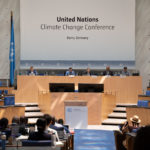The energy system of tomorrow is primarily electrified, digital and flexible, harnessing 100% renewable energy. This system will fully optimise high renewables generation through balancing out supply and demand in a more efficient manner, and allow people to control their energy production and consumption. Households will play a vital role in this system as a source of demand side flexibility by shifting how and when they use electricity thanks to digital technologies, storage, incentives, accessible energy services and tariffs. This shift will reduce household energy costs, enhance energy security and resilience. It will also minimise network investment and constraint costs when we use demand side flexibility to balance the grid.
The current targeted reform of the Electricity Market Design is an opportunity to improve the existing framework and incentives to unlock household flexibility and shape a people-centered market design.
Putting people at the centre to shift paradigm
Let’s start with understanding what ‘baseload’ means in the context of energy generation. Traditionally, baseload refers to the constant and reliable supply of power that meets our everyday energy needs. It refers to the minimum amount of power needed to be supplied to the electrical grid at any given time. However, this model is fast becoming outdated, and for good reason. The rapidly evolving energy sector is moving away from this rigid baseload model to a more flexible and dynamic one. This evolution is primarily driven by the increased integration of renewable energy into our power grids as we phase out fossil fuels.
This change becomes even more crucial in light of the current energy price crisis. Traditionally, it was believed that security of energy supply could only be achieved through centralised energy generation, fossil fuels. This view, however, didn’t adequately consider demand-side measures – the idea of managing energy demand, rather than just relying on increasing the supply. Today, we’re seeing that this traditional view is becoming obsolete, as evident by the fossil gas price crisis. This sentiment is shared by key market actors, including transmission system operators (ENTSO-E).
As we bring more renewable energy online, our energy systems are becoming smarter and more flexible. This shift allows us to balance supply with demand in real-time, freeing us from the constraints of the old baseload model. It also paves the way for demand-side measures to be valued and placed on an equal footing with supply-side solutions, making our energy systems more resilient and efficient.
The cornerstone of building an energy system of tomorrow is to empower and incentivise consumers and households to be more in charge of their demand, also through automated technologies, such as using smart metering and appliances that help to save energy. Installing rooftop solar panels and storing that energy to be released at night-time can help shift electricity consumption at households, with supportive price signals and market incentives.
This puts consumers in the driving seat when it comes to being more efficient with their energy production, consumption and reducing their energy bills. It also further accommodates the integration of variable renewable sources into the electricity grid, reducing the pressure on moments of peak demand, increasing cost-efficiency of grid operation and replacing the price-setting role of fossil fuels.
From House to Grid: How?
Digitalisation is a critical component when it comes to effective demand-side flexibility. Through the use of smart metres and other, more granular metering devices such as sub-meters, consumers are notified when there is a shift in the electricity price. This allows them to plan when they can heat and cool their homes, turn on larger appliances and charge their electric vehicles in order to use onsite generation and system resources in a coordinated and economic way.
In addition, smart appliances and smart charging technology can automatically determine when it’s the best time to consume energy based on the demand within the grid and the price signals from the market. This eliminates the need of consumers to track market signals or prices, and can help balance energy supply and demand more accurately, by shifting controllable loads.
There are also other innovative ways for consumers to decide what portion of their consumption they can make flexible. For example, sub-meters allow consumers to track the usage for their electric heating or electric vehicle (EV) charging, if they choose to make them flexible to get rewarded for their contribution in decreasing the peak demand and lower their bills.
Rooftop solar PV and energy storage also help homes to rely on their own renewable energy during times of peak demand within the grid, avoiding higher energy prices overall and putting less stress on the grid. Any surplus energy stored during times of increased renewable energy generation or lower energy consumption can be used during peak hours. Moreover, this surplus energy can also empower homes to become active players within the energy market, as prosumers (producers+consumers), as it can be shared with their neighbours or sold back to the grid for compensation.
A far more flexible energy market can advance the local ownership of renewable energy production and bolster the growth of energy communities. In fact, energy communities who own their energy production would have major potential in increasing demand-side flexibility. Energy communities embody a vision of a democratic, decentralised energy system that can provide social and economic benefits to their members while also having the capacity to supply the energy grid in times of high demand. A clear win-win.
Policies needed to build the energy system of tomorrow
A strong policy framework that supports individual and collective prosumers, energy communities, energy sharing and recognising the value of local energy ownership, is crucial for empowering people to become active players in the transition to a 100% renewable energy system and achieving climate neutrality. It will also help shield European households from energy price shocks that can be induced by geopolitical conflicts. The energy market design reform, as proposed by the European Commission, is a good first step in this direction.
This transition, however, must be inclusive. To ensure that no one is left behind in the age of digitalisation, targeted support for vulnerable, low-income and middle-income households who can’t afford the latest technology and could lack digital literacy is crucial. Such support can speed up energy savings and the electrification of the residential sector, making it easier for demand-side flexibility measures to be implemented.
Building an energy market that is more flexible, resilient, with equally valuing demand and supply sides is only one piece of the puzzle. We must also act decisively in phasing out expensive and dangerous fossil fuels and the trillions in subsidies they are provided. It’s time to intensify our efforts to decrease energy demand across various sectors, including our buildings, and accelerate the deployment of sustainable renewable energy sources. Together, these actions represent the key starting point for a sustainable, affordable, and secure energy system.
In order to deliver this new energy market reform, policy makers must stay focused on the main objective: ensuring access to secure, sustainable and affordable energy to all via a flexible, decentralised energy system. Any attention shift towards re-enacting subsidies to fossil fuels risks derailing this goal and losing time in accelerating the European energy transition.
Written By CAN Europe with contributions from Regulatory Assistance Project (RAP).
For further reference also see The Joy of Flex report by Regulatory Assistance Project (RAP) and our briefing Energy System of Tomorrow.



